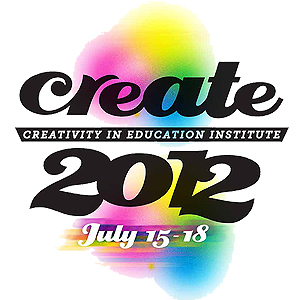How can drawing, painting, playing music and dancing help a child figure out whether a math problem is correct or a science project can work?

Longtime arts educator Cynthia Walker makes a point to fellow teachers during her seminar, "Crayola Dream-Makers Science and Math K-6 Hands-on Connections," during the Tennessee Arts Commission's 2012 "Create2012: Creativity in Education Institute" at MTSU. (MTSU photos by News and Media Relations)
At the Tennessee Arts Commission’s “Create2012: Creativity in Education Institute” this week at MTSU, the methods are as varied—and as colorful—as the big box of 64 crayons inside a third-grader’s desk.
Longtime art educator Cynthia Walker, for example, offered teachers guidance in using art to help youngsters figure out math, science, language arts and social-studies questions and, ultimately, think critically.
Walker, a retired St. Louis, Mo., teacher, now presents the “Crayola Dream-Makers” teacher-training series around the country and travels extensively as a national art consultant for Davis Publications.
“You can explore this process and see what questions your students might have,” Walker explained to about two dozen educators Monday, July 16, in a College of Education classroom. “A kindergartener will always have different questions than a fifth-grader.”
 Create2012 focuses on increasing creativity and collaboration in Tennessee schools. Sessions are being offered for K-12 classroom teachers, assistants, arts specialists, teaching artists, special-education and resource teachers as well as principals and superintendents.
Create2012 focuses on increasing creativity and collaboration in Tennessee schools. Sessions are being offered for K-12 classroom teachers, assistants, arts specialists, teaching artists, special-education and resource teachers as well as principals and superintendents.
For example, Walker demonstrated how making simple paper flowers with coffee filters, crayons and markers can be used to teach young children how money works.
“You put a value on something you’d purchase,” she explained. “These little children are going to become consumers, so we can create a flower, add color to it and put a price tag on it to ‘sell’ it. They’ll make some for the classroom and one to take home as a gift.”
Creating a symmetrical starburst uses math for fractions and gives children an excellent vocabulary-learning opportunity, she said. It also connects with social studies by explaining the background of the colonial star quilt and how pioneers turned used clothing into quilts, curtains and the like.

A participant in the Tennessee Arts Commission's "Create2012: Creativity in Education Institute" turns a paper coffee filter into a colorful, translucent flower during a lesson on teaching chlidren the value of an item.
Walker, who is one of dozens of special speakers scheduled for the attendees through Wednesday, July 18, turned the back of the College of Education classroom into a school-supply aisle as well, eliciting “oooooooohs” when she showed new Crayola items to try out for their students.
The Creativity in Education Institute, inaugurated in 2011, emerged from the commission’s highly successful Value Plus Schools initiative, an arts-integration model with multi-year funding from the U.S. Department of Education.
The Value Plus initiative demonstrated how the arts affect students’ success by helping to close the achievement gap. Value Plus model schools made greater academic gains than the control schools, despite their having a larger number of economically disadvantaged students.
“It’s a great jump-start to the school year,” Andrea Knight, who teaches kindergarten at the Glendale Spanish Immersion Elementary School in Nashville, said of CREATE2012. “The children are very creative on their own, but this is a great chance to get more ideas for them.
“I teach Spanish, so these flowers we’re making are going to be great for what we do as well.”
— Gina E. Fann (Gina.Fann@mtsu.edu)


COMMENTS ARE OFF THIS POST